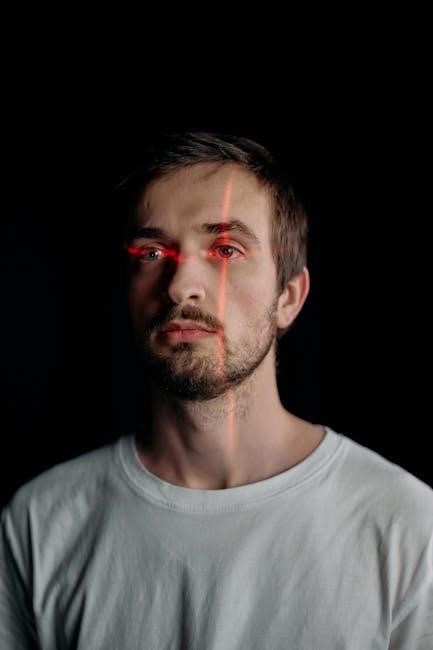Laser hair removal is a popular, non-invasive procedure using concentrated light to target and remove unwanted hair. It’s known for its effectiveness and long-term results, making it a preferred choice for smooth, hair-free skin.
What is Laser Hair Removal?
Laser hair removal is a medical procedure that uses a concentrated beam of light to remove unwanted hair by targeting the hair follicle. It works through selective photothermolysis, where the laser emits light absorbed by melanin in the hair root, damaging the follicle to reduce future growth. Suitable for various body areas, it offers precise, long-lasting results, making it a popular choice for those seeking smooth, hair-free skin with minimal maintenance.
History and Evolution of the Procedure
Laser hair removal has evolved significantly since its inception in the 1990s. Initially, ruby lasers were used but had limitations for darker skin tones. Advances in technology led to the development of Nd:YAG and Alexandrite lasers, improving safety and efficacy for diverse skin types. Today, the procedure is more precise and accessible, offering long-term hair reduction with minimal discomfort, making it a widely accepted solution for unwanted hair removal across various demographics and skin conditions.
Popularity and Common Uses
Laser hair removal has gained immense popularity as a long-term solution for unwanted hair. It is widely used for facial hair, bikini lines, underarms, legs, and back, offering precision and comfort. The procedure is preferred for its effectiveness and minimal maintenance compared to traditional methods. It is also favored by those seeking convenience and aesthetic confidence, making it a go-to choice for diverse demographics, including teenagers and individuals with busy lifestyles, ensuring smooth, hair-free skin with lasting results.

How Laser Hair Removal Works
Laser hair removal uses concentrated light to target melanin in hair follicles, heating and disabling them to delay hair growth. It’s precise and minimally invasive, offering long-term results.
The Science Behind Laser Hair Removal
Laser hair removal relies on the principle of selective photothermolysis, where a laser emits light absorbed by melanin in hair follicles. This light is converted to heat, damaging the follicle while sparing surrounding skin. The process targets pigmented hair, making it most effective for darker hairs. Different lasers, such as diode or Nd:YAG, are used to suit various skin tones, ensuring precise and safe treatment. This technology enables long-term hair reduction by disrupting follicle function.
How Laser Targets Hair Follicles
Laser hair removal targets hair follicles by emitting light that is absorbed by melanin, the pigment in hair. This light energy is converted to heat, which damages the follicle. The laser’s precision ensures it focuses on the hair shaft and root, while cooling devices protect the surrounding skin. The process is most effective when hair is in the active growth phase (anagen), as the laser can target the deepest part of the follicle for optimal results.
This selective targeting minimizes damage to nearby tissues, making the procedure safe and efficient for long-term hair reduction.
Different Types of Lasers Used
Several types of lasers are used for hair removal, each suited for specific skin and hair types. The Alexandrite laser is effective for fair skin, while the Diode laser works well for darker skin tones. The Nd:YAG laser is safe for deep skin tones and sensitive areas. Intense Pulsed Light (IPL) devices are versatile but less precise. Each laser emits specific wavelengths to target hair follicles effectively, ensuring personalized treatment for optimal results.
Choosing the right laser depends on skin color, hair thickness, and treatment area for safe and effective outcomes.

Preparing for Laser Hair Removal
Avoid waxing and plucking for four weeks before treatment, as these methods remove the hair root. Shaving is permitted. Follow specific guidelines to ensure safety and effectiveness.
Pre-Treatment Instructions
Pre-treatment instructions for laser hair removal include avoiding waxing, plucking, and tanning for four weeks prior to the session. Shaving is permitted but should be done 24-48 hours before treatment. Clients should avoid sun exposure, tanning beds, and self-tanning products to reduce the risk of complications. Skins should be clean and free of makeup, lotions, or deodorants on the day of treatment. Inform your practitioner of any medications or medical conditions that may affect the procedure.
Choosing the Right Professional
Selecting a qualified practitioner is crucial for safe and effective laser hair removal. Look for professionals with extensive experience and certifications in dermatology or cosmetic surgery. Ensure the clinic uses FDA-approved lasers suitable for your skin type. Check online reviews and ask for referrals to verify credibility. During consultation, discuss your medical history, skin concerns, and expectations. A reputable professional will tailor the treatment to your needs and explain risks and benefits clearly.
Preparing Your Skin for the Procedure
To ensure optimal results, prepare your skin by avoiding sun exposure for at least one week before treatment. Refrain from using retinoids, bleaching creams, or exfoliating products. Shave the area 24 hours prior to allow the laser to target hair follicles effectively. On the day of the procedure, avoid applying makeup, lotions, or deodorants. Ensure the skin is clean and dry. For sensitive areas, consider timing the procedure when irritation or tanning is minimal for better comfort and outcomes.

The Laser Hair Removal Procedure
Laser hair removal uses concentrated light to target hair follicles, disabling their growth. A trained professional guides the laser, ensuring precise application for safe, effective results.
Step-by-Step Explanation
The procedure begins with preparing the skin, ensuring it’s clean and free of lotions. A cooling gel or numbing cream may be applied to minimize discomfort. The laser is then adjusted according to skin and hair type. The technician guides the laser over the target area, emitting light pulses to target hair follicles. Each pulse lasts a fraction of a second, heating the follicle to disable growth. The process is repeated systematically, ensuring even coverage. Post-treatment, soothing creams or ice packs may be applied to calm the skin.
What to Expect During the Session
During a laser hair removal session, you may feel a mild stinging or snapping sensation, akin to a rubber band hitting the skin. To minimize discomfort, a cooling gel or device is often used. The laser emits light pulses, targeting hair follicles with precision. The session duration varies by area, from a few minutes for small spots to about an hour for larger regions. Post-treatment, mild redness and warmth are common, typically subsiding within hours. Soothing creams or ice packs may be applied to calm the skin.
Duration of the Procedure
The duration of a laser hair removal session varies depending on the area being treated. Small areas, like the face or underarms, may take just a few minutes, while larger areas, such as the legs or back, can take up to an hour. The procedure is typically faster with advanced laser technology. Follow-up sessions are usually spaced 4-6 weeks apart to target hair in different growth phases, ensuring optimal results over time.
Post-Treatment Care and Recovery
After laser hair removal, skin may feel sensitive or appear red. Use mild skincare products, avoid direct sun exposure, and apply sunscreen to protect the treated area.
Immediate Aftercare Tips
After laser hair removal, avoid direct sun exposure for 24-48 hours and apply sunscreen with SPF 30 or higher. Use mild, fragrance-free skincare products to soothe the skin. Avoid swimming, exfoliating, or using harsh chemicals for 24 hours. Gently pat the treated area dry after showering. Avoid tight clothing to prevent irritation. Some patients may experience mild redness or swelling, which typically subsides within a few hours. Following these tips ensures proper healing and minimizes the risk of complications.
Recovery Time and Normal Side Effects
Recovery typically takes a few hours to a day, with most side effects being mild. Common effects include redness, swelling, and a warm sensation at the treatment site. These usually resolve within 24 hours. Some patients may experience mild irritation or dryness, which can be managed with moisturizers. Rarely, temporary changes in skin color may occur. It’s essential to follow post-care instructions to minimize these effects and ensure a smooth recovery. Proper aftercare helps achieve optimal results and reduces risks of complications.
Follow-Up Sessions and Maintenance
Multiple sessions are typically needed for optimal results, spaced 4-6 weeks apart to target hair in different growth phases. Maintenance touch-ups may be required annually to sustain smooth skin. Proper skincare, including sun protection and gentle products, is essential to maintain results. Consistency in follow-ups ensures long-lasting hair reduction and prevents regrowth. Regular maintenance also helps address any stubborn areas, keeping the skin smooth and hair-free over time.

Safety and Risks
Laser hair removal is generally safe but carries risks like temporary redness, irritation, or burns. Improper use can lead to serious complications, including skin discoloration or scarring. Ensuring treatments are performed by experienced professionals minimizes these risks significantly.
Common Side Effects
Common side effects of laser hair removal include mild redness, swelling, and irritation at the treatment site. These typically subside within a few hours. Some individuals may experience temporary dryness or itching. In rare cases, skin cooling systems can cause mild crusting, which heals quickly. These effects are usually mild and temporary, with most patients resuming normal activities immediately after the session. Proper aftercare minimizes discomfort and supports healing.
Rare but Serious Risks
Rare but serious risks of laser hair removal include burns, blisters, or permanent skin color changes, especially in darker skin tones. Scarring can occur if the procedure is not performed correctly. Infection is another rare complication, often due to improper aftercare. Additionally, paradoxical hypertrichosis, where hair growth increases, is a rare side effect. These risks highlight the importance of choosing an experienced professional and following pre- and post-treatment guidelines to ensure safety and optimal results.
Contraindications for the Procedure
Certain conditions make laser hair removal unsuitable. These include pacemakers, metal implants, or active implants, as lasers may interfere with their function. Pregnant or breastfeeding women should avoid the procedure due to hormonal changes. Individuals with certain skin conditions, like porphyria or keloid tendency, are also at higher risk. Additionally, those with a history of seizures triggered by light or taking photosensitizing medications should avoid laser treatments to prevent adverse reactions.
Cost of Laser Hair Removal
Laser hair removal costs vary based on location, provider expertise, and package deals. Sessions can range from $50 to $500, with discounts for multiple treatments.
Average Cost of the Procedure
The average cost of laser hair removal varies depending on the area treated, provider expertise, and location. Small areas, like the underarms, may cost $50-$150 per session, while larger areas, such as the legs or back, can range from $150-$500. Multiple-session packages often reduce the per-session price, offering discounts for upfront payments. Factors like the clinic’s reputation and the technology used also influence pricing. It’s essential to consult with providers to get personalized quotes and compare options.
Factors Influencing the Cost
Several factors influence the cost of laser hair removal. The size and location of the treatment area significantly affect pricing, with smaller areas costing less. The type of laser technology used, such as diode or alexandrite, impacts the cost due to varying effectiveness. Additionally, the expertise and qualifications of the practitioner play a role, as treatments performed by experienced professionals may be more expensive. The number of required sessions and geographic location also contribute to the overall expense, making it essential to consult multiple providers for accurate estimates.
Payment Options and Packages
Many clinics offer flexible payment options and packages to make laser hair removal more accessible. Common options include upfront payments, installment plans, or financing through third-party providers. Some clinics provide package deals for multiple sessions, reducing the cost per treatment. Additionally, discounts are often available for bundling treatments on multiple areas. These options allow individuals to choose a payment method that fits their budget and preferences, ensuring affordability without compromising on quality or results.
Maintaining Results
Maintaining laser hair removal results requires touch-up sessions and proper skincare. Regular treatments ensure long-term hair reduction, while sun protection and avoiding certain hair removal methods preserve outcomes effectively.
Touch-Up Sessions
Touch-up sessions are essential for maintaining optimal results from laser hair removal. Typically scheduled every 4-6 weeks, these sessions target any remaining hair follicles that were not fully affected during initial treatments. Consistency is key, as hair grows in cycles and may require multiple touch-ups to achieve long-term reduction. Regular follow-ups ensure smoother skin and prevent regrowth, making it a crucial part of the overall process for sustained hair-free results.
Home Care and Maintenance Tips
Proper home care enhances laser hair removal results and maintains skin health. Avoid sun exposure and use sunscreen to prevent dark spots. Exfoliate gently to remove dead skin cells, promoting even treatment; Shaving or trimming is allowed, but avoid waxing or plucking between sessions. Keep the skin moisturized to prevent irritation. Adhering to these tips ensures optimal outcomes and supports the effectiveness of the laser treatments, keeping your skin smooth and hair-free for longer periods.
Comparing Laser Hair Removal with Other Hair Removal Methods
Laser hair removal stands out for its long-term results, unlike shaving or waxing. It’s more convenient than electrolysis but requires multiple sessions for optimal effectiveness.
Pros and Cons of Different Methods
Laser hair removal offers long-term results and precision but requires multiple sessions and can be costly. Shaving is quick but causes regrowth and irritation. Waxing provides smooth skin for weeks but is painful. Electrolysis is permanent yet time-consuming. Each method has its advantages and drawbacks, making it essential to choose based on personal preferences and hair removal goals. Understanding these differences helps in selecting the most suitable option for individual needs and expectations. Always consider skin type, budget, and desired outcomes when deciding.
Why Choose Laser Hair Removal?
Laser hair removal stands out for its effectiveness and long-term results, reducing hair regrowth significantly after several sessions. It’s precise, targeting only the hair follicle, and minimizes issues like ingrown hairs. Modern lasers are suitable for various skin tones and areas, offering convenience and comfort. This method is ideal for those seeking smooth, hair-free skin with minimal maintenance. Its popularity grows due to its efficiency and the lasting satisfaction it provides, making it a top choice for many seeking permanent hair reduction.
FAQs About Laser Hair Removal
Common questions include eligibility, number of sessions needed, and expected results. Most experience significant hair reduction, but touch-ups may be required for optimal outcomes.
Common Questions and Concerns
Individuals often inquire about eligibility, session requirements, and expected outcomes. Most experience significant hair reduction, though occasional touch-ups may be needed. Concerns include potential side effects like temporary irritation or changes in skin tone. It’s also common to ask about contraindications, such as tanning or certain medical conditions. Understanding proper pre- and post-care routines is crucial for optimal results. Addressing these questions helps clarify expectations and ensures a safe, effective treatment experience.
Myths and Misconceptions
A common myth is that laser hair removal is painful, but most describe it as mildly uncomfortable. Others believe it’s only for certain skin types, though advancements now cater to various tones. Some think it’s a one-time solution, but multiple sessions are typically needed. Another misconception is that it’s permanent, while results are long-lasting but not always indefinite. Clarifying these myths helps set realistic expectations and ensures informed decisions about the procedure.
Laser hair removal is a safe and effective method for achieving smooth, long-lasting results. Follow proper instructions and consult professionals for personalized advice and optimal outcomes.
Final Thoughts on Laser Hair Removal
Laser hair removal is a trusted solution for long-term hair reduction, offering convenience and effectiveness. While results vary, most experience significant hair reduction with minimal side effects. Proper preparation and aftercare are crucial for optimal outcomes. Consulting a qualified professional ensures safety and tailored treatment, making it a worthwhile investment for those seeking smooth, hair-free skin.
Next Steps for Those Interested
If you’re considering laser hair removal, start by researching reputable clinics and professionals in your area. Schedule a consultation to discuss your specific needs and expectations. Understanding the cost, number of sessions required, and pre-treatment instructions is essential. Be sure to follow all guidelines provided by your practitioner to ensure safety and effectiveness. Taking these steps will help you achieve the best results and make an informed decision about your laser hair removal journey.
